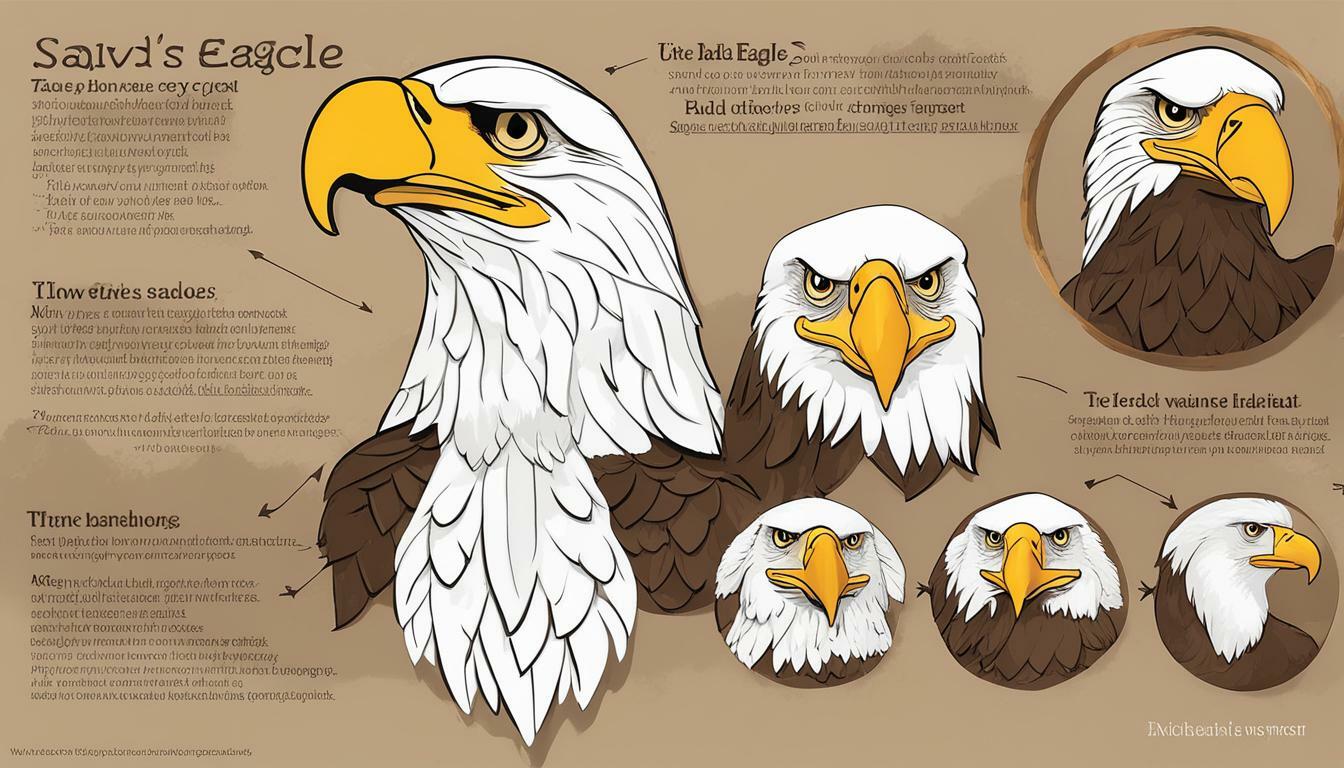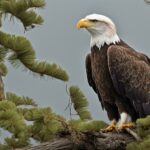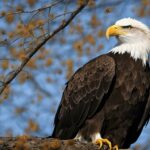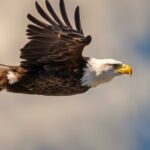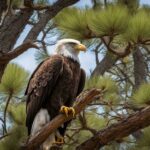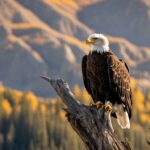When it comes to the bald eagle, there are many questions surrounding their appearance and characteristics. One of the most common questions asked is, “Are bald eagles born with white heads?” The answer to this question may surprise you.
In this article, we will explore the appearance, behavior, and life cycle of bald eagles, with a particular focus on their distinctive white heads. By the end of this article, you’ll have a better understanding of this iconic bird and the significance of their unique characteristics.
Key Takeaways:
- Bald eagles are a symbol of American culture and hold significant ecological importance.
- Bald eagles go through different stages of plumage during their growth and development.
- The white head of bald eagles is an important feature in distinguishing mature individuals from juveniles.
The Appearance of Bald Eagles
When you think of a bald eagle, you likely picture a large bird of prey with a powerful hooked beak and impressive wingspan. These birds are known for their distinctive appearance, which sets them apart from other birds.
Adult bald eagles are primarily brown, with a white head and tail. Their bodies are covered in soft feathers that help keep them warm and dry, while their beaks and talons are sharp and powerful, enabling them to catch and kill prey.
Male bald eagles are slightly smaller than females, with a body length of up to 3 feet and a wingspan of up to 7 feet. Females can grow to be up to 4 feet long with a wingspan of up to 8 feet.
The Distinctive Appearance of Bald Eagles
The distinctive appearance of bald eagles is due in large part to their plumage. While juveniles are primarily brown with some white spotting, adult bald eagles have a striking white head and tail.
This distinctive coloration is not present at birth, however. Juvenile bald eagles have dark brown plumage all over, which gradually lightens as they mature. It can take up to five years for bald eagles to reach their full adult plumage.
Fun Fact: The bald eagle’s scientific name, Haliaeetus leucocephalus, translates to “sea eagle with a white head.”
In addition to their coloration, bald eagles are also known for their powerful hooked beaks, which they use to tear apart prey. They also have sharp talons that help them catch and hold onto their prey, whether that be fish, small mammals, or other birds.
Overall, the appearance of bald eagles is both distinctive and awe-inspiring. These majestic birds are a symbol of strength and power, and their appearance reflects that.
The Plumage of Bald Eagles
Bald eagles, like all birds, start life with a unique set of plumage. Over time, they shed their feathers and grow new ones until they reach their final, mature look. The plumage of bald eagles changes drastically from when they are born to when they reach adulthood.
When bald eagles hatch, their feathers are mostly brown and gray. As they age, they develop a mottled brown-and-white plumage and a black beak with a blue-gray base. By the age of four or five, they reach sexual maturity and have a completely white head and tail. Their eyes turn from brown to yellow and they develop a sharp, curved beak that is useful for hunting and scavenging.
The transformation from juvenile to adult plumage can take up to five years, during which the eagles shed their feathers and grow new ones. The white head and tail feathers are the last to appear, and signify the bird’s maturity.
It’s interesting to note that bald eagles mate for life and will often perform aerial courtship displays, showcasing their impressive plumage and acrobatic abilities. The more mature and regal an eagle appears, the more attractive they are to potential mates.
The Life Cycle of Bald Eagles
Bald eagles go through several stages of development in their life cycle. The process begins with the eggs hatching and the emergence of the juveniles, which are marked by distinctive characteristics that set them apart from the mature adults.
During the first year of their life, bald eagles undergo several changes that affect their appearance. One of the most notable changes is the transformation of their body size, as juveniles grow rapidly and develop new feathers that replace their downy plumage.
At around four to five weeks, the juveniles begin to display signs of fledging as they gain strength and coordination in their wings. During this time, their bodies become more streamlined, and their feathers become more defined.
| Life Stage | Appearance |
|---|---|
| Juvenile | Brown or mottled feathers, brown eyes, yellow beak, and gray legs and feet |
| Sub-adult | Intermediate plumage with scattered white feathers on the underside, yellow eyes, and a dark beak |
| Adult | Distinctive white head and dark brown body feathers, yellow beak and eyes, and yellow legs and feet |
As they approach their second year, the juveniles begin to develop the characteristic white head and dark brown body feathers that distinguish adult bald eagles. This transformation marks the transition from the sub-adult stage to adulthood.
Overall, the life cycle of bald eagles is a fascinating process that highlights the species’ unique physical characteristics and growth patterns.
The Symbolism of the Bald Eagle
As a national symbol of the United States, the bald eagle holds significant cultural and historical importance. Its white head and powerful presence make it a recognizable and revered figure in American society.
The eagle has been featured on various national emblems, including the Great Seal of the United States, as a symbol of strength, freedom, and courage. Its appearance, particularly the distinctive white head, has played a crucial role in establishing its symbolic significance.
The bald eagle represents freedom, strength, and power; its white head is emblematic of wisdom and maturity.
Not only is the bald eagle a prominent figure in American culture, but it is also considered a spiritual symbol by many Native American tribes. It is believed to possess healing powers and to act as a messenger between humans and the divine.
Overall, the bald eagle’s symbolism is deeply ingrained in American history and culture. Its white-headed appearance adds to its aura of wisdom and power, making it an enduring symbol of the nation’s values and ideals.
Behavior of Bald Eagles
Observing the behavior of bald eagles is an incredible experience. These birds are highly social creatures, often seen interacting with each other in aerial displays that involve soaring, diving, and grappling with their talons.
In addition to their impressive flying skills, bald eagles are also excellent hunters. They use their sharp eyesight to locate prey, such as fish and small mammals, from great distances. They then swoop down and snatch their prey with their powerful talons, before carrying it back to their nests to feed their young.
Bald eagles are also known for their strong bond with their mates. They form pairs for life, and both partners contribute to the care and upbringing of their offspring. This includes incubating and protecting the eggs, as well as providing food for the eaglets once they hatch.
Their behavior and appearance are closely linked
Bald eagles’ behavior is closely linked to their appearance. For example, their distinctive white head and tail feathers make them easy to spot from a distance, which helps them to locate each other while foraging or traveling. Additionally, their sharp talons and hooked beak are essential tools for capturing and eating prey, while their keen eyesight allows them to spot potential threats and prey from afar.
Overall, the behavior of bald eagles is a testament to their remarkable adaptability and resilience. Despite numerous threats to their survival, including habitat loss and pollution, these birds continue to thrive in many parts of North America, thanks to ongoing conservation efforts and the tireless work of dedicated wildlife experts and enthusiasts.
The Significance of White Heads in Bald Eagles
One of the most striking features of the bald eagle is its white head, which stands out against its dark brown body. But why do bald eagles have white heads? As eagles mature, they slowly replace their dark feathers with white ones, and it can take up to five years for their heads and tails to turn completely white. The white feathers are a sign of maturity and are used to distinguish adult eagles from juveniles.
The white head also plays an important role in eagle behavior. When two eagles meet, they will often engage in an aerial display, circling each other and calling out. During this display, they will puff up their chest feathers to make themselves look bigger and will turn their heads to display their white feathers. This is a way for eagles to show off their age and strength to potential mates or competitors.
Interesting Facts About Bald Eagles
Did you know that bald eagles can see at least four times farther than humans? Their sharp vision comes in handy when hunting prey.
Bald eagles are also known for their impressive diving skills. They can reach speeds of up to 100 miles per hour when diving to catch their prey!
Contrary to popular belief, bald eagles aren’t actually bald. In fact, they have white feathers on their heads that contrast with their dark brown bodies.
Bald eagles have a wingspan of up to 8 feet, making them one of the largest birds in North America. They can weigh up to 14 pounds, with females being larger than males.
These birds are also known for their unique courtship rituals, which involve aerial displays and cartwheels.
Bald eagles are incredibly resilient creatures. They can survive in a wide range of environments, from coastal areas to forests and even deserts.
Did you know that bald eagles are monogamous? They mate for life and will only find a new partner if their previous one dies.
Bald eagles are also important indicators of ecosystem health. Their presence in an area can signal a healthy ecosystem, while their absence can indicate environmental problems.
Finally, bald eagles are a symbol of America’s strength and resilience. They were chosen as the national bird in 1782 and have since become an iconic representation of the United States.
The Role of Bald Eagles in the Ecosystem
Bald eagles play a critical role in their respective ecosystems as apex predators. Their presence ensures a balance in the food chain and has a positive impact on the environment.
One notable characteristic of bald eagles is their ability to hunt and consume a variety of prey. They primarily feed on fish, but they also consume birds, reptiles, and small mammals. This diverse diet makes them an important force in regulating the populations of numerous species.
Bald eagles also contribute to nutrient cycling in their ecosystems. As they hunt and consume their prey, they leave behind carcasses and other waste. These remains are then decomposed by bacteria and fungi, releasing essential nutrients back into the soil.
Additionally, bald eagles are an indicator species, meaning their presence or absence can provide insight into the health of their ecosystem. If their populations decline, it may suggest that there are issues with the environment, such as pollution or habitat loss.
Overall, bald eagles are vital components of their ecosystems, supporting the food chain, nutrient cycling, and serving as indicators of ecosystem health. Their conservation is crucial for not only their survival, but also for the health and balance of their habitats.
Conservation Efforts for Bald Eagles
Due to their protected status, bald eagles have made a remarkable recovery in recent years. The species was removed from the endangered list in 1995 and their population has continued to grow ever since.
Conservation efforts to protect bald eagles have included habitat preservation, breeding programs, and enforcing regulations to prevent hunting and habitat destruction. The Bald and Golden Eagle Protection Act was passed in 1940, which made it illegal to take, kill, possess, sell, or transport eagles. In addition, the Endangered Species Act was established in 1973, which provided further protection for the species and their habitats.
Today, many organizations work together to monitor and protect bald eagles, including the U.S. Fish and Wildlife Service, National Audubon Society, and the American Eagle Foundation. These groups use a variety of techniques, such as banding and tracking eagles, to gather information about the species and to better understand their behaviors and ecological needs.
Conclusion
Congratulations! You have learned a lot about bald eagles, from their appearance and behavior to their ecological significance and conservation efforts. So, are bald eagles born with white heads? The answer is no. Juvenile bald eagles have brown heads and tails, while the distinctive white head and tail do not appear until adulthood. Bald eagles are truly fascinating creatures with unique characteristics that make them an important part of our ecosystem. Their symbolism in American culture is also significant, representing strength, freedom, and courage. It is important to protect these stunning birds and their habitats, which is why conservation efforts continue to be implemented. By learning more about bald eagles and supporting conservation efforts, we can ensure that these majestic creatures continue to thrive for generations to come. Thank you for joining us on this educational journey about bald eagles!Do Bald Eagles Have any Adaptations for Swimming?
Bald eagles and their swimming abilities have been a subject of curiosity for nature enthusiasts. While these magnificent birds are primarily known for their aerial prowess, they also possess adaptations for swimming. Their razor-sharp talons and strong wings help them navigate through water bodies, enabling them to catch fish and other prey in a seamless, swift manner. The exceptional swimming skills of bald eagles further showcase their versatility in various habitats.
FAQ
Q: Are bald eagles born with white heads?
A: No, bald eagles are not born with white heads. They actually have dark brown feathers when they are young, and their distinctive white heads and tails develop as they mature.
Q: What is the general appearance of bald eagles?
A: Bald eagles are large birds with a wingspan of up to 7 feet. They have a dark brown body and wings, with a white head and tail. Their beaks and feet are bright yellow.
Q: How does the plumage of bald eagles change?
A: Bald eagles go through different stages of plumage as they grow. Juvenile bald eagles have mostly dark brown feathers, and it takes about 4-5 years for them to develop the iconic white head and tail of adults.
Q: What is the life cycle of bald eagles?
A: Bald eagles start as eggs, hatching into fuzzy grayish-brown chicks. They then go through the fledgling stage, where they learn to fly and hunt. As they mature, their appearance gradually changes, with the white head and tail developing in adulthood.
Q: What is the symbolism of bald eagles?
A: Bald eagles are a symbol of strength, freedom, and patriotism in American culture. Their majestic appearance, including their white heads, represents power and resilience.
Q: What are the behavior patterns and habits of bald eagles?
A: Bald eagles are known for their impressive hunting and fishing skills. They build large nests called eyries in tall trees near bodies of water. They are also known for their soaring flights and distinctive vocalizations.
Q: Why do some bald eagles have white heads?
A: The white head in bald eagles is a sign of maturity. It distinguishes adult birds from juveniles, allowing them to establish their dominance and attract mates.
Q: What are some interesting facts about bald eagles?
A: Bald eagles have a lifespan of up to 30 years in the wild. They can reach speeds of up to 40 miles per hour during flight. They also have amazing eyesight, which allows them to spot their prey from great distances.
Q: What is the role of bald eagles in the ecosystem?
A: Bald eagles play a crucial role in the ecosystem as top predators. They help control populations of fish and small mammals, contributing to the overall balance of their habitats.
Q: What conservation efforts are in place for bald eagles?
A: Bald eagles are protected under the Bald and Golden Eagle Protection Act and the Migratory Bird Treaty Act. These laws prohibit the hunting, possession, and disturbance of bald eagles and their nests, helping to ensure their conservation.

